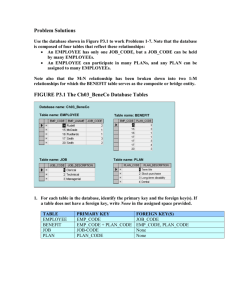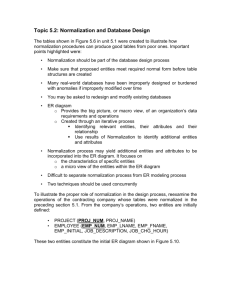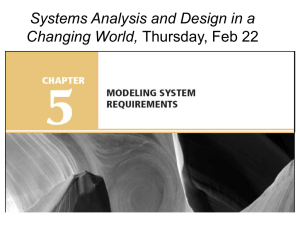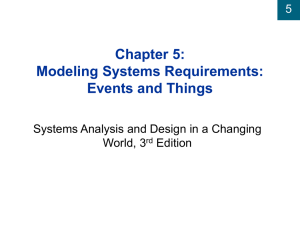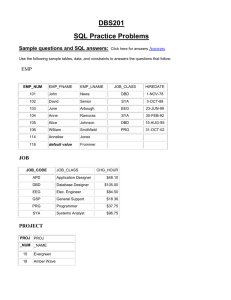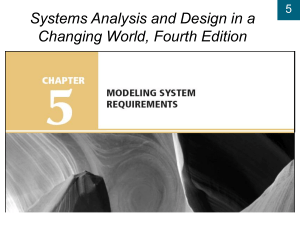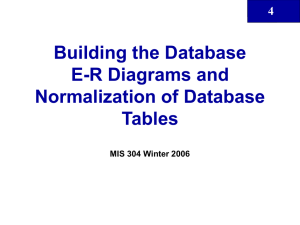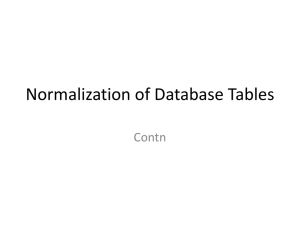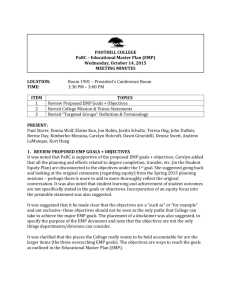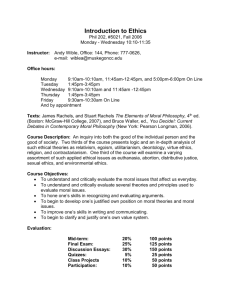Database Normalization & ER Modeling: Contracting Company Example
advertisement
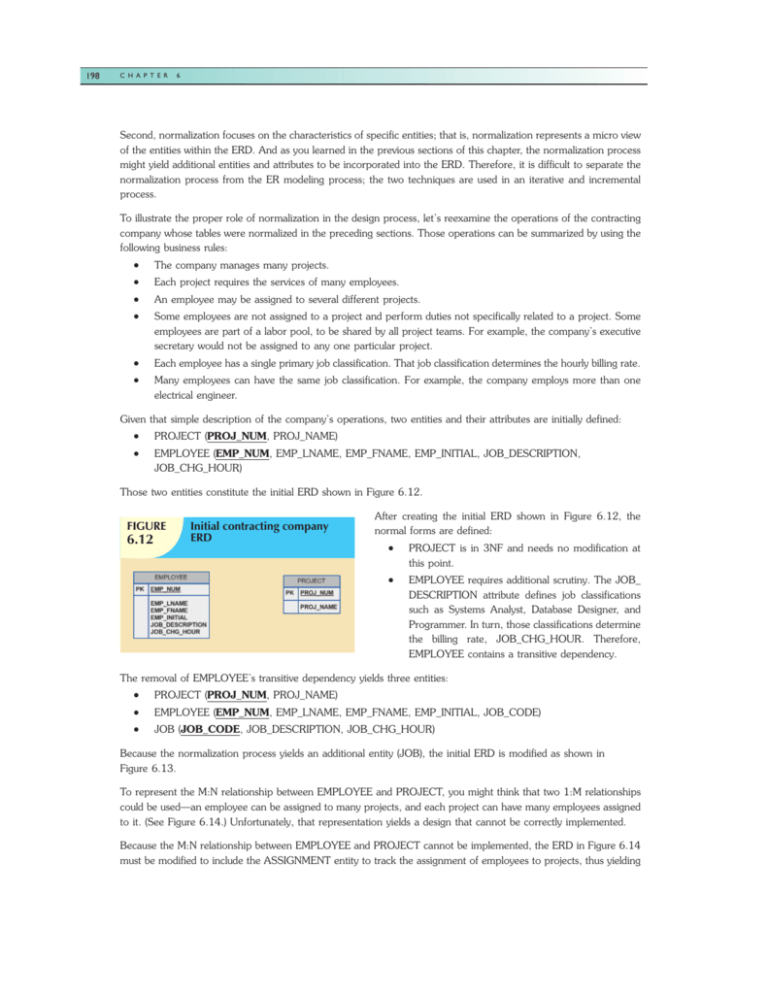
198 C H A P T E R 6 Second, normalization focuses on the characteristics of specific entities; that is, normalization represents a micro view of the entities within the ERD. And as you learned in the previous sections of this chapter, the normalization process might yield additional entities and attributes to be incorporated into the ERD. Therefore, it is difficult to separate the normalization process from the ER modeling process; the two techniques are used in an iterative and incremental process. To illustrate the proper role of normalization in the design process, let’s reexamine the operations of the contracting company whose tables were normalized in the preceding sections. Those operations can be summarized by using the following business rules: ! The company manages many projects. ! Each project requires the services of many employees. ! An employee may be assigned to several different projects. ! Some employees are not assigned to a project and perform duties not specifically related to a project. Some employees are part of a labor pool, to be shared by all project teams. For example, the company’s executive secretary would not be assigned to any one particular project. ! Each employee has a single primary job classification. That job classification determines the hourly billing rate. ! Many employees can have the same job classification. For example, the company employs more than one electrical engineer. Given that simple description of the company’s operations, two entities and their attributes are initially defined: ! PROJECT (PROJ_NUM, PROJ_NAME) ! EMPLOYEE (EMP_NUM, EMP_LNAME, EMP_FNAME, EMP_INITIAL, JOB_DESCRIPTION, JOB_CHG_HOUR) Those two entities constitute the initial ERD shown in Figure 6.12. FIGURE 6.12 Initial contracting company ERD After creating the initial ERD shown in Figure 6.12, the normal forms are defined: ! PROJECT is in 3NF and needs no modification at this point. ! EMPLOYEE requires additional scrutiny. The JOB_ DESCRIPTION attribute defines job classifications such as Systems Analyst, Database Designer, and Programmer. In turn, those classifications determine the billing rate, JOB_CHG_HOUR. Therefore, EMPLOYEE contains a transitive dependency. The removal of EMPLOYEE’s transitive dependency yields three entities: ! PROJECT (PROJ_NUM, PROJ_NAME) ! EMPLOYEE (EMP_NUM, EMP_LNAME, EMP_FNAME, EMP_INITIAL, JOB_CODE) ! JOB (JOB_CODE, JOB_DESCRIPTION, JOB_CHG_HOUR) Because the normalization process yields an additional entity (JOB), the initial ERD is modified as shown in Figure 6.13. To represent the M:N relationship between EMPLOYEE and PROJECT, you might think that two 1:M relationships could be used—an employee can be assigned to many projects, and each project can have many employees assigned to it. (See Figure 6.14.) Unfortunately, that representation yields a design that cannot be correctly implemented. Because the M:N relationship between EMPLOYEE and PROJECT cannot be implemented, the ERD in Figure 6.14 must be modified to include the ASSIGNMENT entity to track the assignment of employees to projects, thus yielding N O R M A L I Z A T I O N FIGURE Modified contracting company ERD FIGURE Incorrect M:N relationship representation 6.13 6.14 O F D A T A B A S E TA B L E S the ERD shown in Figure 6.15. The ASSIGNMENT entity in Figure 6.15 uses the primary keys from the entities PROJECT and EMPLOYEE to serve as its foreign keys. However, note that in this implementation, the ASSIGNMENT entity’s surrogate primary key is ASSIGN_NUM, to avoid the use of a composite primary key. Therefore, the “enters” relationship between EMPLOYEE and ASSIGNMENT and the “requires” relationship between PROJECT and ASSIGNMENT are shown as weak or nonidentifying. Note that in Figure 6.15, the ASSIGN_HOURS attribute is assigned to the composite entity named ASSIGNMENT. Because you will likely need detailed information about each project’s manager, the creation of a “manages” relationship is useful. The “manages” relationship is implemented through the foreign key in PROJECT. Finally, some additional attributes may be created to improve the system’s ability to generate additional information. For example, 199 200 C H A P T E R FIGURE 6.15 6 Final contracting company ERD you may want to include the date on which the employee was hired (EMP_HIREDATE) to keep track of worker longevity. Based on this last modification, the model should include four entities and their attributes: PROJECT (PROJ_NUM, PROJ_NAME, EMP_NUM) EMPLOYEE (EMP_NUM, EMP_LNAME, EMP_FNAME, EMP_INITIAL, EMP_HIREDATE, JOB_CODE) JOB (JOB_CODE, JOB_DESCRIPTION, JOB_CHG_HOUR) ASSIGNMENT (ASSIGN_NUM, ASSIGN_DATE, PROJ_NUM, EMP_NUM, ASSIGN_HOURS, ASSIGN_CHG_ HOUR, ASSIGN_CHARGE) The design process is now on the right track. The ERD represents the operations accurately, and the entities now reflect their conformance to 3NF. The combination of normalization and ER modeling yields a useful ERD, whose entities may now be translated into appropriate table structures. In Figure 6.15, note that PROJECT is optional to EMPLOYEE in the “manages” relationship. This optionality exists because not all employees manage projects. The final database contents are shown in Figure 6.16. 6.8 DENORMALIZATION It’s important to remember that the optimal relational database implementation requires that all tables be at least in third normal form (3NF). A good relational DBMS excels at managing normalized relations; that is, relations void of any unnecessary redundancies that might cause data anomalies. Although the creation of normalized relations is an important database design goal, it is only one of many such goals. Good database design also considers processing (or reporting) requirements and processing speed. The problem with normalization is that as tables are decomposed to conform to normalization requirements, the number of database tables expands. Therefore, in order to generate information, data must be put together from various tables. Joining a large number of tables takes additional input/output (I/O) operations and processing logic, thereby reducing system speed. Most relational database systems are able to handle joins very efficiently. However, rare and occasional circumstances may allow some degree of denormalization so processing speed can be increased.
